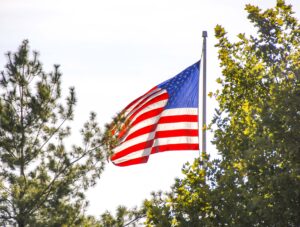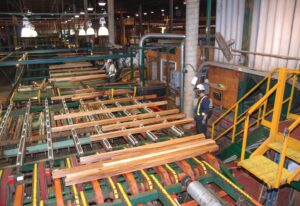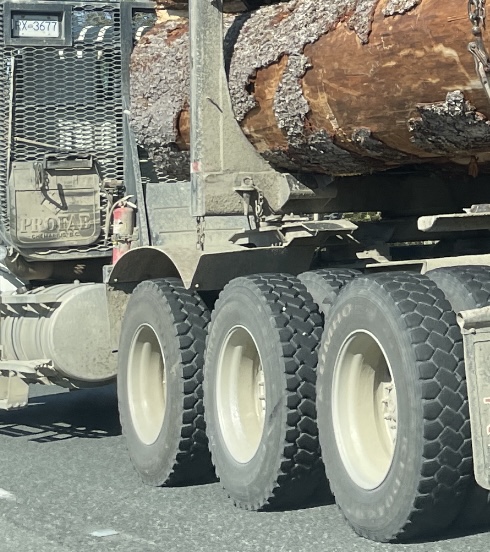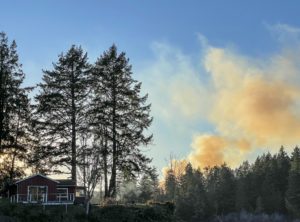Canada is making progress on “small” tariff deals with the US for key sectors, Prime Minister Mark Carney said after revealing he’d had a recent phone call with U.S. President Donald Trump. Carney said he spoke with Trump “at length” Monday on a wide range of issues, including trade, geopolitics and employment. He described it as a “good conversation” but also warned there is no guarantee Ottawa will secure any of the deals under discussion as the Trump administration works to squeeze the Canadian economy to obtain trade concessions. …While Carney did not specify which key sectors are the subjects of trade talks, the sectors targeted by US tariffs include steel, aluminum, forestry products and automobiles. …Carney’s cabinet met behind closed doors Wednesday at a Toronto hotel — part of its preparations for the upcoming fall sitting of Parliament and for continuing negotiations with the Americans on tariffs.

 Lumber prices that have dropped more than 20% over the past month are prompting one of North America’s largest producers to throttle back output by 12%. Interfor said Thursday that it would reduce hours and reconfigure shifts as well as lengthen holiday breaks and maintenance shutdowns at its mills in Canada and the US to reduce output by about 145 million board feet through year-end. Lumber futures, which had fallen 18 of the past 22 trading sessions rose in response. …Interfor, which has headquarters in BC, is among the big Canadian sawyers that have shifted operations into the US as duties and diminished log availability have put sawmills out of the money back home. About 50% of Interfor’s capacity these days is in the US South. Another 12% is Washington and Oregon, where mills compete fiercely with Canadian rivals to sell the same species of wood. [to access the full story a WSJ subscription is required]
Lumber prices that have dropped more than 20% over the past month are prompting one of North America’s largest producers to throttle back output by 12%. Interfor said Thursday that it would reduce hours and reconfigure shifts as well as lengthen holiday breaks and maintenance shutdowns at its mills in Canada and the US to reduce output by about 145 million board feet through year-end. Lumber futures, which had fallen 18 of the past 22 trading sessions rose in response. …Interfor, which has headquarters in BC, is among the big Canadian sawyers that have shifted operations into the US as duties and diminished log availability have put sawmills out of the money back home. About 50% of Interfor’s capacity these days is in the US South. Another 12% is Washington and Oregon, where mills compete fiercely with Canadian rivals to sell the same species of wood. [to access the full story a WSJ subscription is required] BURNABY, BC — Interfor Corporation announced plans to reduce its lumber production by approximately 145 million board feet between September and December of 2025, representing approximately 12% of its normal operating stance. The temporary curtailments will be through a combination of reduced operating hours, prolonged holiday breaks, reconfigured shifting schedules and extended maintenance shut-downs. The curtailments are expected to impact all of Interfor’s operating regions, with both the Canadian and US operations expected to reduce their production levels by approximately 12% each. The curtailments are in response to persistently weak market conditions and ongoing economic uncertainty. The Company will continue to monitor market conditions across all of its operations and adjust its production plans accordingly. [END]
BURNABY, BC — Interfor Corporation announced plans to reduce its lumber production by approximately 145 million board feet between September and December of 2025, representing approximately 12% of its normal operating stance. The temporary curtailments will be through a combination of reduced operating hours, prolonged holiday breaks, reconfigured shifting schedules and extended maintenance shut-downs. The curtailments are expected to impact all of Interfor’s operating regions, with both the Canadian and US operations expected to reduce their production levels by approximately 12% each. The curtailments are in response to persistently weak market conditions and ongoing economic uncertainty. The Company will continue to monitor market conditions across all of its operations and adjust its production plans accordingly. [END] WASHINGTON — US President Trump is indicating that he’ll ask the Supreme Court tomorrow to overturn a federal appeals court ruling that found many of his
WASHINGTON — US President Trump is indicating that he’ll ask the Supreme Court tomorrow to overturn a federal appeals court ruling that found many of his 
 Treasury Secretary Scott Bessent said the Trump administration may declare a national housing emergency this fall as the White House looks to highlight key issues for midterm campaign voters. …Bessent said housing affordability would be a critical leg of Republicans’ 2026 midterm election platform. Bessent declined to list any specific actions the president may take, but he suggested that administration officials are directly studying ways to standardize local building and zoning codes and decrease closing costs. President Trump has repeatedly used emergency declarations to avoid having to send legislation to Congress for approval. Some of those, particularly the emergency law he cited to institute his tariff regime, have faced pushback in federal court. …Trump also spoke out on the issue during the campaign and said he wants to open up federal land for housing development and pledged to help with affordability by eliminating regulations.
Treasury Secretary Scott Bessent said the Trump administration may declare a national housing emergency this fall as the White House looks to highlight key issues for midterm campaign voters. …Bessent said housing affordability would be a critical leg of Republicans’ 2026 midterm election platform. Bessent declined to list any specific actions the president may take, but he suggested that administration officials are directly studying ways to standardize local building and zoning codes and decrease closing costs. President Trump has repeatedly used emergency declarations to avoid having to send legislation to Congress for approval. Some of those, particularly the emergency law he cited to institute his tariff regime, have faced pushback in federal court. …Trump also spoke out on the issue during the campaign and said he wants to open up federal land for housing development and pledged to help with affordability by eliminating regulations.



 Falling lumber prices are sounding an alarm on Wall Street about potential problems on Main Street. Wood markets have been whipsawed of late by trade uncertainty and a deteriorating housing market. Futures have dropped 23% since hitting a three-year high at the beginning of August and ended Friday at $535 per thousand board feet. The price drop might have been greater—but two of North America’s biggest sawyers said last week that they would curtail output, slowing the decline. Crashing wood prices are troubling because they have been a reliable leading indicator on the direction of the housing market as well as broader economic activity. …Analysts and traders say there will have to be further cuts to ease the glut of wood. That might not be a problem, given how higher duties have pushed up Canadian sawmills’ break-even prices while demand wanes. “We anticipate further closures or curtailments,” said Truist Securities analyst Michael Roxland. [to access the full story a WSJ subscription is require]
Falling lumber prices are sounding an alarm on Wall Street about potential problems on Main Street. Wood markets have been whipsawed of late by trade uncertainty and a deteriorating housing market. Futures have dropped 23% since hitting a three-year high at the beginning of August and ended Friday at $535 per thousand board feet. The price drop might have been greater—but two of North America’s biggest sawyers said last week that they would curtail output, slowing the decline. Crashing wood prices are troubling because they have been a reliable leading indicator on the direction of the housing market as well as broader economic activity. …Analysts and traders say there will have to be further cuts to ease the glut of wood. That might not be a problem, given how higher duties have pushed up Canadian sawmills’ break-even prices while demand wanes. “We anticipate further closures or curtailments,” said Truist Securities analyst Michael Roxland. [to access the full story a WSJ subscription is require] Lumber futures fell again Wednesday, dropping to their lowest prices since last autumn. …Futures for September delivery shed $6 or about 1.1%, to end at $524 per thousand board feet. Futures have now declined 18 of the past 22 trading sessions. The selloff—about 25% over the past month—is reminiscent of the wild trading in lumber during the Covid-19 pandemic [but this time] …the continuing gyrations have been driven by trade policy. Lumber buyers stocked up ahead of a big increase in the duties levied on Canadian imports. …President Trump’s threats for additional tariffs on imported wood added incentive to hoard lumber. …The $54 difference in price between lumber futures for delivery this month and those for November in midday trading was well above the cost of warehousing wood for two months and a sign that traders’ demand outlook is bleak, Stinson Dean said. [to access the full story a WSJ subscription is required]
Lumber futures fell again Wednesday, dropping to their lowest prices since last autumn. …Futures for September delivery shed $6 or about 1.1%, to end at $524 per thousand board feet. Futures have now declined 18 of the past 22 trading sessions. The selloff—about 25% over the past month—is reminiscent of the wild trading in lumber during the Covid-19 pandemic [but this time] …the continuing gyrations have been driven by trade policy. Lumber buyers stocked up ahead of a big increase in the duties levied on Canadian imports. …President Trump’s threats for additional tariffs on imported wood added incentive to hoard lumber. …The $54 difference in price between lumber futures for delivery this month and those for November in midday trading was well above the cost of warehousing wood for two months and a sign that traders’ demand outlook is bleak, Stinson Dean said. [to access the full story a WSJ subscription is required]

 Lumber prices, which shed more than 20% in August, have continued to fall to start September, hitting their lowest price this year thanks to a glut of wood that was piled up ahead of a big increase in duties on Canadian imports. “There has clearly been a speculative inventory accumulation at every level from mills to single location lumber dealers,” said Matt Layman, who publishes Layman’s Lumber Guide “For the first time in my 40-plus year career there is indeed a wall of wood that must be liquidated.” As with many raw materials, the lumber market has been whipsawed by President Trump’s tariff threats. The White House is studying tariffs on imported lumber in the name of national security. …Any lumber tariff will come on top of duties on Canadian softwood lumber that rose to about 35% for most producers, from 15% last year. [to access the full story a WSJ subscription is required]
Lumber prices, which shed more than 20% in August, have continued to fall to start September, hitting their lowest price this year thanks to a glut of wood that was piled up ahead of a big increase in duties on Canadian imports. “There has clearly been a speculative inventory accumulation at every level from mills to single location lumber dealers,” said Matt Layman, who publishes Layman’s Lumber Guide “For the first time in my 40-plus year career there is indeed a wall of wood that must be liquidated.” As with many raw materials, the lumber market has been whipsawed by President Trump’s tariff threats. The White House is studying tariffs on imported lumber in the name of national security. …Any lumber tariff will come on top of duties on Canadian softwood lumber that rose to about 35% for most producers, from 15% last year. [to access the full story a WSJ subscription is required] Lumber futures fell to $550 per thousand board feet in September, the lowest in nearly four months, amid softer demand for new home building and ample supply. US building permits fell 2.2% in July to a seasonally adjusted annualized rate of 1.362 million, the lowest since June 2020. Although the market anticipates a potential rate cut in September, rates are expected to remain restrictive, and high inflation expectations are expected to support long-maturity yields, which dictate mortgage costs. Seasonal slowdown in construction is set to magnify the drop in housing construction. On the supply side, Canadian mills continue to push large volumes of surplus lumber into the US market, far exceeding actual demand and creating an oversupply situation. Additionally, ongoing tariff issues between the US and Canada add further uncertainty, as potential changes in trade policy could significantly affect US lumber prices.›
Lumber futures fell to $550 per thousand board feet in September, the lowest in nearly four months, amid softer demand for new home building and ample supply. US building permits fell 2.2% in July to a seasonally adjusted annualized rate of 1.362 million, the lowest since June 2020. Although the market anticipates a potential rate cut in September, rates are expected to remain restrictive, and high inflation expectations are expected to support long-maturity yields, which dictate mortgage costs. Seasonal slowdown in construction is set to magnify the drop in housing construction. On the supply side, Canadian mills continue to push large volumes of surplus lumber into the US market, far exceeding actual demand and creating an oversupply situation. Additionally, ongoing tariff issues between the US and Canada add further uncertainty, as potential changes in trade policy could significantly affect US lumber prices.› Construction spending in the United States reached $1,232.7 billion during the first seven months of 2025, a 2.2% decrease from $1,259.9 billion in the same period of 2024. Residential construction accounted for $524.7 billion, down 4.0%, while nonresidential construction declined 0.8% to $707.9 billion, according to the U.S. Census Bureau. Private construction dropped 3.8% year-to-date to $946.5 billion. …Public construction increased 3.8% to $286.2 billion over the same period. …For the month of July 2025, construction spending was at a seasonally adjusted annual rate of $2,139.1 billion, down 0.1% from June and 2.8% below July 2024. Private sector construction decreased 0.2% from the previous month, while public construction rose 0.3%.
Construction spending in the United States reached $1,232.7 billion during the first seven months of 2025, a 2.2% decrease from $1,259.9 billion in the same period of 2024. Residential construction accounted for $524.7 billion, down 4.0%, while nonresidential construction declined 0.8% to $707.9 billion, according to the U.S. Census Bureau. Private construction dropped 3.8% year-to-date to $946.5 billion. …Public construction increased 3.8% to $286.2 billion over the same period. …For the month of July 2025, construction spending was at a seasonally adjusted annual rate of $2,139.1 billion, down 0.1% from June and 2.8% below July 2024. Private sector construction decreased 0.2% from the previous month, while public construction rose 0.3%.


 National forests and wildfire will return to the congressional agenda this week with a pair of House subcommittee hearings on Forest Service programs. The Trump administration’s challenges in managing the 193-million-acre forest system with a sharply reduced workforce — and a big agency reorganization still to come — are likely topics for both the Agriculture and Natural Resources subcommittees. In the Natural Resources hearing, the Subcommittee on Federal Lands will take testimony on the state of national forests, picking up on a hearing that was initially scheduled for July 9. In the Agriculture hearing, the Subcommittee on Forestry and Horticulture will focus on improved active forest management, such as increased thinning of national forests to reduce potential wildfire fuel. [to access the full story an E&ENews subscription is required]
National forests and wildfire will return to the congressional agenda this week with a pair of House subcommittee hearings on Forest Service programs. The Trump administration’s challenges in managing the 193-million-acre forest system with a sharply reduced workforce — and a big agency reorganization still to come — are likely topics for both the Agriculture and Natural Resources subcommittees. In the Natural Resources hearing, the Subcommittee on Federal Lands will take testimony on the state of national forests, picking up on a hearing that was initially scheduled for July 9. In the Agriculture hearing, the Subcommittee on Forestry and Horticulture will focus on improved active forest management, such as increased thinning of national forests to reduce potential wildfire fuel. [to access the full story an E&ENews subscription is required]
 Under the 2001 Roadless Rule enacted by President Bill Clinton, millions of acres of roadless areas on national forests across the country are conserved, protecting vital habitats and watersheds. A “blank spot on a map,” in the words of the naturalist Aldo Leopold, is increasingly valuable in our urbanizing society. …The current administration is right to look for ways to address the growing wildfire threat in these areas. But instead of doing away with the Roadless Rule, the White House should look to a simple way to make our forests more resilient to wildfire without compromising the other benefits. …One way to allow forest thinning and prescribed burns to reduce the wildfire threat is to amend the roadless rule… to permit temporary roads in roadless areas that are near neighborhoods along the wildland-urban interface to allow for forest thinning or other ecological restoration. [to access the full story a NY Times subscription is required]
Under the 2001 Roadless Rule enacted by President Bill Clinton, millions of acres of roadless areas on national forests across the country are conserved, protecting vital habitats and watersheds. A “blank spot on a map,” in the words of the naturalist Aldo Leopold, is increasingly valuable in our urbanizing society. …The current administration is right to look for ways to address the growing wildfire threat in these areas. But instead of doing away with the Roadless Rule, the White House should look to a simple way to make our forests more resilient to wildfire without compromising the other benefits. …One way to allow forest thinning and prescribed burns to reduce the wildfire threat is to amend the roadless rule… to permit temporary roads in roadless areas that are near neighborhoods along the wildland-urban interface to allow for forest thinning or other ecological restoration. [to access the full story a NY Times subscription is required]
 Colorado’s state-specific rule for largely protecting roadless areas in its national forests will be spared from a Trump administration effort to remove such protections on a broader basis. Agriculture Secretary Brooke Rollins said in a news release on Wednesday that a public comment period is opening on her previously announced proposal to do away with the 2001 national roadless rule. But the Agriculture Department also said in the news release that state-specific rules in Colorado and Idaho won’t be affected by the proposal. Altogether, the proposal would apply to nearly 45 million acres, the release said. Eliminating the rule would open roadless areas to road-building. The existing rule has limited activities such as logging in those areas, and was instituted at the end of the Clinton administration.
Colorado’s state-specific rule for largely protecting roadless areas in its national forests will be spared from a Trump administration effort to remove such protections on a broader basis. Agriculture Secretary Brooke Rollins said in a news release on Wednesday that a public comment period is opening on her previously announced proposal to do away with the 2001 national roadless rule. But the Agriculture Department also said in the news release that state-specific rules in Colorado and Idaho won’t be affected by the proposal. Altogether, the proposal would apply to nearly 45 million acres, the release said. Eliminating the rule would open roadless areas to road-building. The existing rule has limited activities such as logging in those areas, and was instituted at the end of the Clinton administration. A year after Oregon endures its most destructive fire season on record in 2020, state lawmakers order a map estimating the wildfire risk for every property in the state. It’s the kind of rating now available on real estate sites like Zillow. The state wants to use the results to decide where it will apply forthcoming codes for fire-resistant construction and protections around homes. Around the same time, insurance companies start dropping Oregon homeowners’ policies and raising premiums to limit future losses, much as they have done in other disaster-prone states. Insurers have their own sophisticated risk maps to guide them, but some brokers instead tell homeowners the blame lies with the map. The belief gets treated as fact both on social media and in mainstream news — even though insurers and regulators say it’s not true. …By the time the state pulls back the map, the myths about it have gained so much momentum there’s no stopping them.
A year after Oregon endures its most destructive fire season on record in 2020, state lawmakers order a map estimating the wildfire risk for every property in the state. It’s the kind of rating now available on real estate sites like Zillow. The state wants to use the results to decide where it will apply forthcoming codes for fire-resistant construction and protections around homes. Around the same time, insurance companies start dropping Oregon homeowners’ policies and raising premiums to limit future losses, much as they have done in other disaster-prone states. Insurers have their own sophisticated risk maps to guide them, but some brokers instead tell homeowners the blame lies with the map. The belief gets treated as fact both on social media and in mainstream news — even though insurers and regulators say it’s not true. …By the time the state pulls back the map, the myths about it have gained so much momentum there’s no stopping them. 
 For a small but growing number of Oregon forestland buyers, timber output is no more than a potential byproduct. Their purchases are driven less by a desire for logs than for clean, drinkable water. …city governments have long drawn their drinking water from surrounding forests, but experts say more are now actually buying the tracts encompassing those crucial streams and rivers. …The prospect of hotter, drier weather diminishing summer stream flows — even as populations keep growing — is spurring cities to assert more control over their water supplies, experts say. …Apart from water quality considerations, cities are buying forested watersheds to encourage old growth characteristics, with the intent of actually boosting water supplies over the long term, experts say. …Though municipal ownership of forest watersheds is intended to pre-empt disputes between cities and timber operators, the arrangement can still lead to tension over management decisions.
For a small but growing number of Oregon forestland buyers, timber output is no more than a potential byproduct. Their purchases are driven less by a desire for logs than for clean, drinkable water. …city governments have long drawn their drinking water from surrounding forests, but experts say more are now actually buying the tracts encompassing those crucial streams and rivers. …The prospect of hotter, drier weather diminishing summer stream flows — even as populations keep growing — is spurring cities to assert more control over their water supplies, experts say. …Apart from water quality considerations, cities are buying forested watersheds to encourage old growth characteristics, with the intent of actually boosting water supplies over the long term, experts say. …Though municipal ownership of forest watersheds is intended to pre-empt disputes between cities and timber operators, the arrangement can still lead to tension over management decisions. The US Department of Agriculture (USDA) announced it would invest more than $8 million in five new projects, including one in North Carolina. These projects will improve forest health by reducing wildfire risk and improving water quality. …North Carolina has two primary wildfire seasons, one in the spring and one in the fall. …The five new projects include efforts across several states to restore and protect essential landscapes. The National Forest is launching the “Alabama Chattahoochee Fall Line Restoring Longleaf” project in Alabama. Colorado and Wyoming will see work in the Medicine Bow-Routt National Forest through the “Headwaters of the Colorado” initiative. Montana’s Lolo National Forest is beginning the “Blackfoot River Valley Landscape Mosaic” project, while North Carolina’s National Forests are moving forward with “Uwharries to Sandhills, Phase 2.” Finally, Oregon’s Mt. Hood National Forest will focus on “Hood River Wildfire and Watershed Resilience.”
The US Department of Agriculture (USDA) announced it would invest more than $8 million in five new projects, including one in North Carolina. These projects will improve forest health by reducing wildfire risk and improving water quality. …North Carolina has two primary wildfire seasons, one in the spring and one in the fall. …The five new projects include efforts across several states to restore and protect essential landscapes. The National Forest is launching the “Alabama Chattahoochee Fall Line Restoring Longleaf” project in Alabama. Colorado and Wyoming will see work in the Medicine Bow-Routt National Forest through the “Headwaters of the Colorado” initiative. Montana’s Lolo National Forest is beginning the “Blackfoot River Valley Landscape Mosaic” project, while North Carolina’s National Forests are moving forward with “Uwharries to Sandhills, Phase 2.” Finally, Oregon’s Mt. Hood National Forest will focus on “Hood River Wildfire and Watershed Resilience.”

 The federal government is attempting to abandon years of climate science and regulation, and officials from Washington state are warning those efforts will drastically slow the country’s ability to cut greenhouse gas emissions. The U.S. Environmental Protection Agency no longer wants to classify greenhouse gas emissions as dangerous and, therefore, something that must be regulated. The agency is now in the middle of a public comment process to reverse its long-standing course. Public officials and climate change experts from across the country are testifying against the federal government’s new direction. Among those in opposition is Joel Creswell, who manages the climate pollution reduction program with Washington state’s Department of Ecology. He said the EPA’s process is built on unscientific research and cherry-picked data. It’s also likely illegal, Creswell said. The federal government is trying to provide the “appearance of a science-based reason” not to regulate greenhouse gases, Creswell said.
The federal government is attempting to abandon years of climate science and regulation, and officials from Washington state are warning those efforts will drastically slow the country’s ability to cut greenhouse gas emissions. The U.S. Environmental Protection Agency no longer wants to classify greenhouse gas emissions as dangerous and, therefore, something that must be regulated. The agency is now in the middle of a public comment process to reverse its long-standing course. Public officials and climate change experts from across the country are testifying against the federal government’s new direction. Among those in opposition is Joel Creswell, who manages the climate pollution reduction program with Washington state’s Department of Ecology. He said the EPA’s process is built on unscientific research and cherry-picked data. It’s also likely illegal, Creswell said. The federal government is trying to provide the “appearance of a science-based reason” not to regulate greenhouse gases, Creswell said.



 Border Patrol agents arrested two firefighters Wednesday – who they say were in the United States illegally – while they were working to contain Washington state’s biggest wildfire. …The Bear Gulch Fire on the peninsula has already torched almost 9,000 acres in the Olympic National Forest. …The human-caused wildfire on Washington’s Olympic Peninsula has been burning since July 6 and was just 13% contained as of Thursday. …Washington Gov. Bob Ferguson said he is “deeply concerned” about the arrests. Washington Sen. Patty Murray said, “Trump has undercut our wildland firefighting abilities in more ways than one—from decimating the Forest Service and pushing out thousands of critical support staff, to now apparently detaining firefighters on the job.” Under the Biden administration, the Department of Homeland Security said it would not conduct immigration enforcement “at locations where disaster and emergency response and relief is being provided” such as evacuation routes or areas where emergency supplies are being distributed.
Border Patrol agents arrested two firefighters Wednesday – who they say were in the United States illegally – while they were working to contain Washington state’s biggest wildfire. …The Bear Gulch Fire on the peninsula has already torched almost 9,000 acres in the Olympic National Forest. …The human-caused wildfire on Washington’s Olympic Peninsula has been burning since July 6 and was just 13% contained as of Thursday. …Washington Gov. Bob Ferguson said he is “deeply concerned” about the arrests. Washington Sen. Patty Murray said, “Trump has undercut our wildland firefighting abilities in more ways than one—from decimating the Forest Service and pushing out thousands of critical support staff, to now apparently detaining firefighters on the job.” Under the Biden administration, the Department of Homeland Security said it would not conduct immigration enforcement “at locations where disaster and emergency response and relief is being provided” such as evacuation routes or areas where emergency supplies are being distributed.

